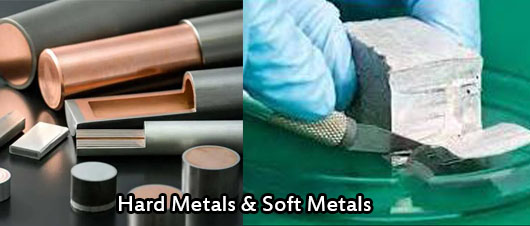CNC machining involves cutting, milling, or turning materials to create precise parts and components. We often encounter two types of metals: hard metal and soft metal. These two materials have their unique characteristics and application scenarios in mechanical processing. The choice of metal for CNC machining depends on the specific application, design requirements, and desired properties.
Hard Metals
1. Common Hard Metals:
Hard metals, also known as hard alloys or cemented carbides, often refer to materials like tungsten carbide, cobalt-chromium alloys, and tool steels.
2. Properties:
Hard metals exhibit high hardness, wear resistance, and strength. They are capable of withstanding high temperatures and are often used in applications where abrasion and wear are critical factors.
In CNC machining, cutting hard metals requires the use of larger diameter cutting tools, higher cutting speeds, and deeper cutting depths. Choosing the correct cutting parameters is crucial to prevent overheating and excessive wear.
3. Applications:
Cutting Tools: Hard metals are extensively used in the production of cutting tools, drills, end mills, and inserts due to their exceptional hardness and wear resistance.
Wear Parts: They are suitable for manufacturing wear parts in industries such as mining, machining, and oil and gas, where resistance to abrasion is crucial.
Tool and Die Making: Hard metals are preferred for tool and die applications where the tool needs to withstand repeated use and maintain its sharpness.

4. Challenges:
Machining hard metals can be challenging due to their hardness. Specialized cutting tools and machining techniques, such as high-speed machining and advanced tool coatings, are often required.
Soft Metals:
1. Common Soft Metals:
Soft metals typically refer to materials like aluminum, brass, copper, and certain grades of steel.
2. Properties:
Soft metals are characterized by their lower hardness and higher ductility. They are generally easier to machine and form, making them suitable for a wide range of applications.
In CNC machining, smaller cutting depths, lower cutting speeds, and softer cutting tools are usually used for cutting soft metals. Accurate control of cutting temperature and cutting force is the key to ensuring machining quality.
3. Applications:
Automotive Components: Soft metals are commonly used in the automotive industry for components like brackets, housings, and heat exchangers.
Aerospace Parts: Aluminum alloys are frequently used in aerospace applications due to their lightweight nature.
Consumer Electronics: Soft metals are used in the production of parts for consumer electronics, such as aluminum casings for smartphones and laptops.
Prototyping: Soft metals are often chosen for rapid prototyping due to their ease of machining.
4. Advantages:
Soft metals are generally easier to machine, reducing tool wear and extending tool life.
They often have better thermal conductivity, making them suitable for applications where heat dissipation is important.
Choosing Between Hard and Soft Metals:
Mechanical properties of alloys
Let’s start with mechanical properties, which are measured by the performance of materials when different forces are applied.
The primary key mechanical properties that metals should consider are:
Elasticity (Hard metals are often more elastic than soft metals)
Hardness (hard metal)
Strength (hard metal)
Ductility (Soft Metal)
Density (ranging from soft to hard according to density ratio)
Magnetic (steel)
Damping (Hard metals often have smaller damping capacity)
Fracture toughness (the range of fracture toughness is the highest for all metals, but it is the toughest from soft to hard)
Wear resistance and fatigue resistance of metals
Usually, if you are processing a part to achieve prototype assembly and functionality, you don’t need to worry about material wear and tear. Your material selection will be very important if you need guaranteed strength, or if the parts may have to withstand extreme temperatures and other environmental real estate tests.
Corrosion resistance (oxidation resistance) of metals
The corrosion of alloys is caused by chemical reactions between the alloy and the surrounding environment, resulting in deterioration or oxidation. There are many reasons for metal corrosion, and it is worth noting that all metals will corrode. Pure iron usually corrodes quickly, but stainless steel combined with iron and other alloys corrodes slowly. If you are concerned about corrosion, stainless steel is a good choice.
Another alternative to stainless steel is anodizing aluminum. This method helps to reduce corrosion and is definitely a very durable finish.
The Manufacturability of Metals
When it comes to manufacturability, each supplier or manufacturing partner may have a different set of requirements based on their capabilities. If you find that your parts cannot be processed and your part design has almost no flexibility, you may need to change the manufacturing method to 3D printing, which provides unique solutions in metal and plastic.
Metal Cost
The last important element we need to examine before selecting materials is usually cost. But if you have more property demands or needs, you are likely to pay more for these materials. Soft metals are usually more cost-effective and easier to process, which may be an important factor in mass production.
In summary, the choice between hard and soft metals in CNC machining depends on the specific needs of the application. Hard metals offer superior hardness and wear resistance, while soft metals provide advantages in terms of machinability and cost-effectiveness. The selection should align with the desired properties of the final product and the challenges posed by the machining process.



